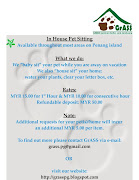By S.S. YOGA
Photos by RAYMOND OOI and courtesy of Heath Nash
South African designer Heath Nash uses unusual materials for his designs and work to save the environment at the same time.
MALAYSIA is one of the world’s leading producers of palm oil. However, the industry generates plenty of waste by-products, including oil palm frond, normally used for mulching.
 Mind at work: ‘Naturally, I’m always thinking of what other materials I can work with,’ says Heath Nash.
Mind at work: ‘Naturally, I’m always thinking of what other materials I can work with,’ says Heath Nash. Unfortunately, some plantations choose to burn them, which is illegal and worse, pollutes the environment.
Instead of resorting to such unhealthy practices, why not study the use of fronds as weaving material? The fronds could be a suitable and cheaper alternative to the traditional mengkuang/pandan (screw pines), nipah (Nypa fruticans), rattan and bamboo for making baskets and mats. This would be a sensible course of action when you consider the gradual destruction of forests and mangroves, and the dwindling supply of natural materials.
South African designer Heath Nash had this flash of an idea when his plane was landing at KLIA during his maiden trip to Malaysia and he saw the vista of oil palm plantations before him. He was in town for the inaugural KL Design Week (March 27 to April 4), as an exhibitor and featured presenter.
Sometimes, it takes someone looking in from the outside to come up with the possibilities. But then again, Nash has had practice exploring unusual materials to craft his handiwork.
The genesis for that idea can be traced back to Design Indaba, an exhibition at one of South Africa’s premier international design expos held in Cape Town in 2004. Visitors had commented that his designs did not reflect a South African identity.
 Shipshape: How each bottle is cut up according to its hidden forms.
Shipshape: How each bottle is cut up according to its hidden forms. “Yes, my designs looked like they could have been from Japan or Sweden. The need for an identity didn’t occur to me before that. So I did a little investigating. For me, what reflected South Africa was the galvanised wires fashioned into craft items like bicycles and other objects which you see everywhere. Naturally, I’m always thinking of what other materials I can work with,” explained the 31-year-old Nash.
He graduated in 1999 from the Michaelis School of Fine Art at University of Cape Town with a degree in sculpture. In his fourth year, he garnered the sculpture prize by making foldable and collapsible geometric paper, and cardboard “toys” which he called “unstable structures”.
Nash decided to “look at material for material’s sake” to explore what designs could be fashioned out of them. He said that it was a radical approach that worked backwards, rather than the usual way of coming up with a design and then, looking for the material later.
That led to his use of plastic bottles, more specifically polypropylene (PP) bottles, the kind normally used for detergent and fabric softeners.
The process of experimenting with paper, folds and simple spatial structures led to his fascination with modular structures (large structures made from many smaller unitary parts). Nash used the same principles for working with paper to work with plastic, or “other people’s rubbish,” as he called it. He wanted to explore the environmental angle and use recycled parts as the underlying philosophy for his work.
 Maths test: Flowers being shaped and counted.
Maths test: Flowers being shaped and counted. The first functional art object to come out of his work was lampshades; the most famous being his flowerball lampshades.
“I actually learnt the technique of cutting up the bottles and fashioning my first designs from a Zimbabwean named Richard Mandongwe. I’m originally from Bulaweyo, Zimbabwe, myself.
“Mandongwe learnt the technique from his wife Juliette Katane, who came up with the technique in high school. It’s a great story because it was thanks to the work that she did with recycled plastic bottles that they both managed to bring their three children to South Africa and escape the repressive regime of (Robert) Mugabe,” he explained.
Nash noted that besides the environmental angle to the business, he wanted to have micro-economic spinoffs and spread the economic influence in the community. As such, he helped set up a company to take over the task of collecting, cleaning and cutting the bottles.
 Base level: Bottle bases can also be light installations.
Base level: Bottle bases can also be light installations. “It saved me a lot of time and enabled me to concentrate on the design work. It also meant that other people could reap the rewards of the business as I now buy material from them.”
He has employed three craftsmen and an administrative assistant. Business is good with mainly export orders from Scandinavia, Australia and the United States.
Nash said that much of his publicity comes from attending various design exhibitions around the globe and from ensuing media coverage. He is well known in South Africa itself.
His work is even covered in the school curriculum in high school in the subject of design technology.
“It’s an honour, yes, but it’s also good that children are taught new ways and encouraged to experiment with different ideas to make a living. I’ve had many meetings and queries from students on how to go about this. In fact, it was my high school teacher who encouraged me and nurtured my passion for the arts,” he added.
 Strip me: Strips from PET bottles fashioned into a lampshade.
Strip me: Strips from PET bottles fashioned into a lampshade. Nash noted that the British Council’s International Young Design Entrepreneur of the Year award, for which he was the South African finalist in 2006, provided a huge impetus for him. It opened his eyes to the fact that his work could be accepted and acknowledged at that level.
The jury in London described his work as “highly creative and uniquely able to integrate design, craft and art. Heath Nash presented an intelligent synthesis of scrap into beauty.”
His creativity has extended to different plastic materials like polyethylene terephthalate (PET), commonly used for drinking bottles, which he cuts into strips. Nash is looking at the possibility of collaborating with traditional bamboo weavers in Japan, using these PET strips. He’s even going outside his comfort zone and looking at how wood waste from the furniture industry can be used in his work.
When he was in KL, all Nash could think about was the materials used for handicrafts produced in our country. Nash was pleased as punch to discover the Karyaneka Kuala Lumpur Craft Complex where he went on a shopping spree!
As someone who’s used to thinking out of the box, Nash is contemplating persuading the industries who use these plastic materials to actually fashion the bottles according to his requirements.
Now, that would certainly fit into the theme of his exhibition here: “This feels like the future!”











































No comments:
Post a Comment